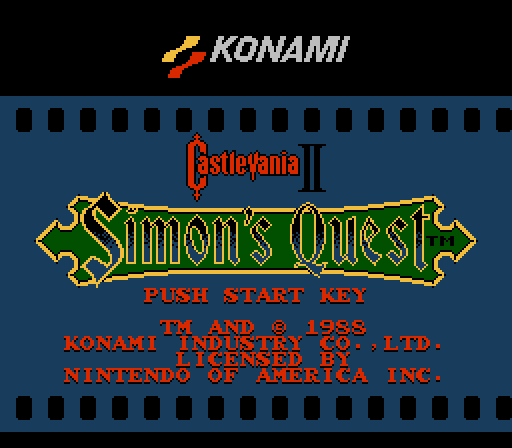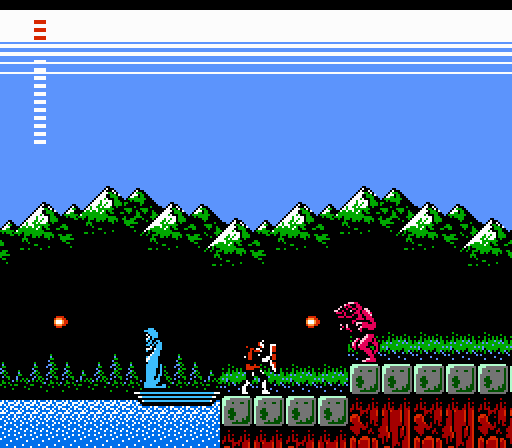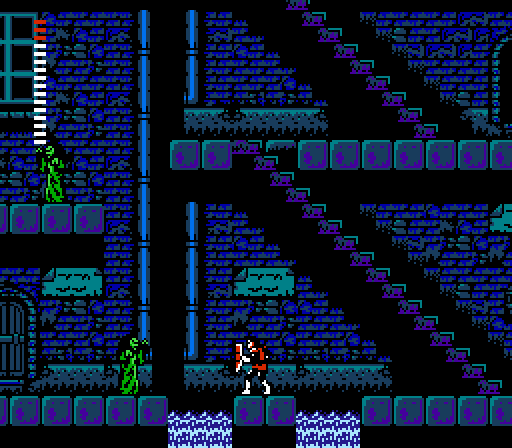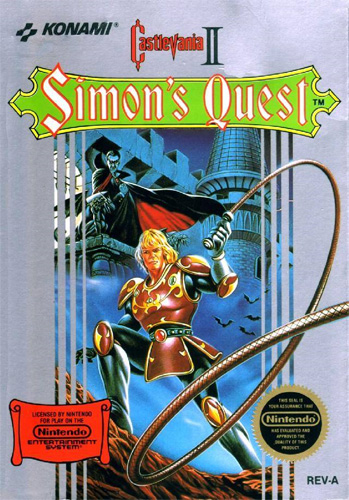Castlevania II: Simon’s Quest

| Rating | |
|---|---|
| Graphics: | 4 |
| Sound: | 5 |
| Control: | 4 |
| Depth: | 5 |
| Overall: | 4 |
Castlevania II: Simon’s Quest
By: Konami
Released: 1988
I fondly remember Simon’s Quest, not as a “guilty pleasure”, but as one of my favorite games on the NES. Yet, in many ways, it’s an unruly mess of a game. The castles themselves present little challenge; most of them don’t even have a boss monster. Taking the shortest amount of time to complete the game grants what is arguably the worst ending. The townsfolk offer very obscure clues; some of them even lie! Perhaps most egregious, a few of the required tricks to continue your quest are so obtuse, that they are nigh impossible to solve without the use of a FAQ (or Nintendo Power).
So why haven’t I let the facts get in the way of my opinion? Do 80s gamers have Stockholm syndrome when it comes to what we’ll endure for our interactive entertainment? Maybe so, and Simon’s Quest is surely not without flaws, but here is what I think the game got right:
“What a horrible night to have a curse.”
Simon’s Quest was one of the first console games to effectively feature a day and night cycle. At night, monsters dealt twice the damage and towns were deserted, apart from roaming zombies. A seemingly simple ploy, but it helped create the illusion of a real “lived-in” locale.
Exploring more than just a castle.
While not quite offering a whole world, Simon’s Quest did present a large region of Transylvania to discover, with a myriad of towns, countryside, swampland, caves, and yes...castles. Due to this expanded scope, the graphics did lose some of their architectural details from the first Castlevania, but still offered a solid sense of place – even if it was a slightly surreal one with underground towns and underwater secret passages.
Action-RPG please, but not too much.
Simon still upgrades his whip and collects secondary items, but they don’t go away after losing a life. Hearts are still spent on usage of (at least some of the) secondary weapons, but they also double as currency with town merchants. Add in a modest leveling system, and you have a nice smattering of RPG elements, without detracting from the basic game-play of “jump and whip”. Speaking of items...
Better tools, and more of them.
No longer limited to a single secondary weapon, Simon now acquires two whole rows of items. Holy Water now serving the useful purpose of revealing secret passages and Dracula’s Rib providing Simon the rather awesome ability to block fireballs are just two examples.
“...easy to learn and difficult to master.” [1]
With less elaborate enemy movement, far less death-defying platforming and essentially infinite lives, the game could seem way too easy – even for players who didn’t master the difficult first Castlevania. Yet this makes it all the more inviting to explore Transylvania, figuring out what to do and where to go. Plus, a higher level of play is available – beating the game quickly earns the alternate ending(s).
So, Simon’s Quest does not quite live up to its ambitions, and honestly, many of its problems could have been solved with one more editorial pass of the villager dialogue. Yet, for all that, it successful builds on Castlevania as a place. Many of its successors have cherry picked different ideas from the game, but none are a remake or sequel, save for an homage in one stage of Castlevania: Rondo of Blood. Simon’s Quest remains unique. If you’ve never played the game, give it a try. Just don’t be afraid to look up a hint or two, and remember, “Laurels in your soup enhances its aroma.”
[1] Nolan Bushnell
- Ben Langberg


